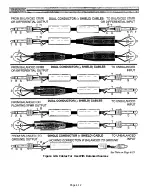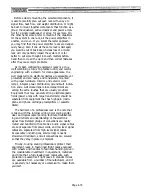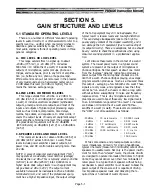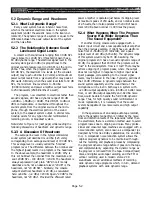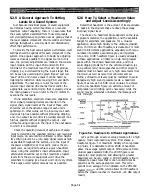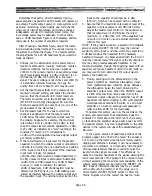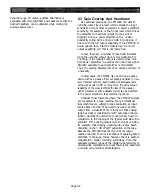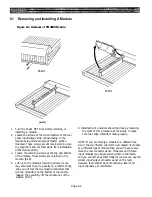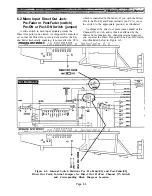
dynamic range. Of course, another alternative is
available: add more amplifiers and speakers so that the
5.3 Gain Overlap And Headroom
desired headroom can be obtained while raising the
As explained previously, the PM4000 can deliver
average power level.
+24 dBu output level, a level which exceeds the input
sensitivity of most other equipment. A power amplifier's
sensitivity, for example, is that input level which drives
the amplifier to maximum output (to the point of
clipping). Hence, a power amplifier with a +4 dBu
sensitivity rating will be driven 20 dB into clipping if
driven with the full output capability of the PM4000. It
would appear, then, that the console has “too much”
output capability, but this is not really true.
In fact, there are a number of real-world instances
when the +24 dBu output drive is very desirable. For
one thing, if the console’s output is used to drive mul-
tiple power amplifiers in parallel, then the input signal
strength available to each amplifier is diminished.
Thus, the overlap becomes less of an excess and more of
a necessity.
In other cases, the PM4000 may be driving a passive
device such as a passive filter set, graphic equalizer or low-
level crossover network. Such devices will attenuate some
of the signal, often 6 dB or more. Here, the extra output
capability of the console offsets the loss of the passive
signal processor so that adequate signal can be delivered
to the power amplifiers, tape machine inputs, etc.
Consider those instances where the PM4000 outputs
are connected to a tape machine. Many professional
tape machines are subject to tape saturation at input
levels above +15 dBu. Why would one want +24 dBu
output from a console? Well, it turns out that analog
tape has what is considered a “soft” saturation charac-
teristic, whereby the distortion is not terribly harsh in
comparison to the clipping of the typical solid state line
amplifier. If the mixing console were to clip at +18 dBu,
for example, that clipping would overlay a very harsh
distortion on the 3 dB of “soft” saturation on the tape.
Because the PM4000 does not clip until its output
r24 dBu, there is less chance of applying harsh
distortion to the tape. Today, however, there is another
consideration: digital recording technology. Here, the
available dynamic range of the digital tape recorders or
direct-to-disk recorders is so great that all the headroom
a console can provide is advantageous.
Page 5-6
Summary of Contents for PM4000
Page 1: ...PROFESSIONAL AUDIO MIXING CONSOLE PM4000 OPERATING MANUAL YAMAHA ...
Page 2: ...PM4000 OPERATING MANUAL ...
Page 7: ...Section 1 Introduction ...
Page 11: ...Section 2 Brief Operating Instruction ...
Page 47: ...Section 3 Specifications ...
Page 51: ...Dimensional Drawings PM4000 Console all versions Page 3 4 ...
Page 52: ...Page 3 5 ...
Page 53: ...Page 3 6 PM4000 Console Rear Profiles ...
Page 54: ...Module Block Diagrams See back of the manual for overall system block diagram Page 3 7 ...
Page 55: ...Page 3 8 ...
Page 56: ...Page 3 9 ...
Page 57: ...Page 3 10 ...
Page 58: ...Page 3 11 ...
Page 59: ...Page 3 12 ...
Page 60: ...Section 4 Installation Notes ...
Page 72: ...Figure 4 13 Cables For Use With Balanced Sources Page 4 12 ...
Page 79: ...SECTION 5 Gain Structure and Levels ...
Page 82: ...Figure 5 1 Dynamic Range and Headroom in Sound Systems Page 5 3 ...
Page 86: ...Section 6 Optional Functions ...
Page 106: ...Section 7 Operating Notes and Hints ...
Page 119: ...Section 8 Applications ...
Page 127: ...Section 9 Maintenance ...
Page 131: ......
Page 132: ...YAMAHA VN02300 ...


